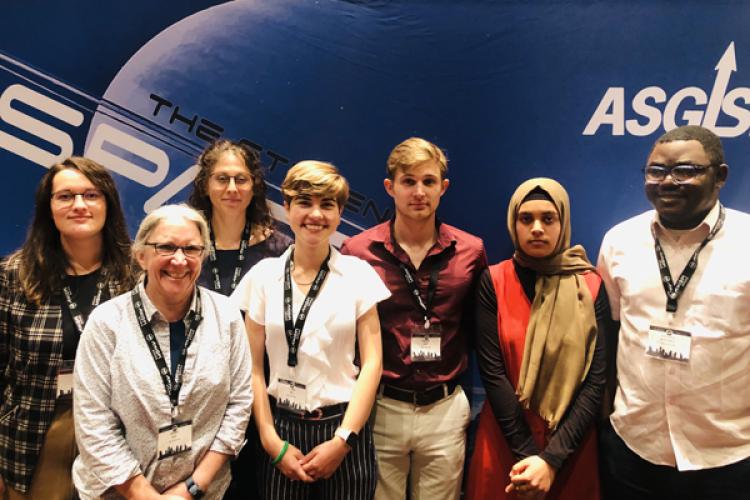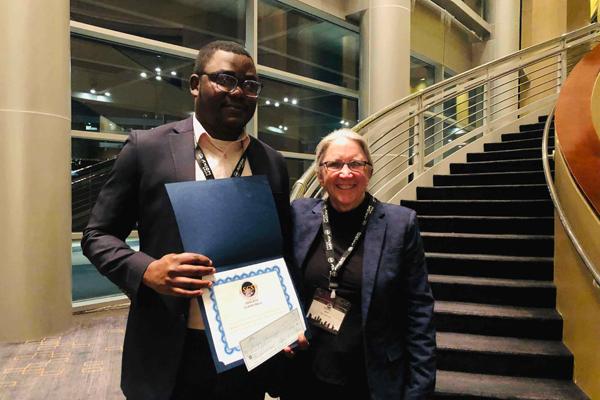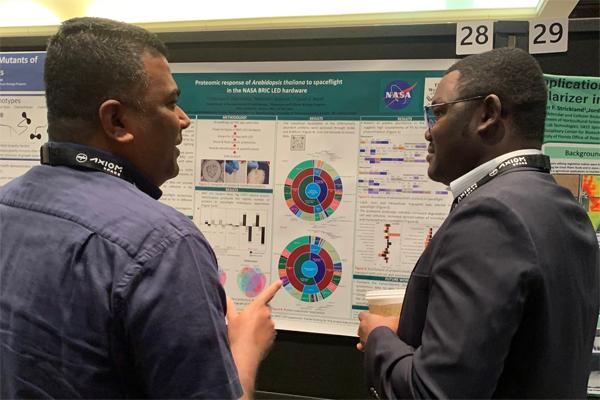
Gbolaga Olanrewaju wins top graduate award, first place for poster at gravitational and space research conference

Gbolaga Olanrewaju won the top graduate student award and first place for his research poster at the American Society for Gravitational and Space Research meeting in Houston as he and other students in Sarah Wyatt's lab presented about their recent experiments involving the International Space Station (ISS).
The ASGSR brought together experts from academic institutions, NASA, and commercial space organizations in November to focus on biological and physical responses to variable gravity conditions.
Olanrewaju, a plant biology doctoral student in the College of Arts and Sciences at Ohio University, said it was amazing to hear his name announced as the winner of the Tom K. Scott award for significance in the field of Gravitational and Space Research for graduate student research.

"This is the highest award given to a graduate student by the society, and it is a recognition of the significant contribution to space and gravitational research in the world. I also won a cash price for the first place graduate student poster," Olanrewaju said.
"I was glad to be able to meet and discuss various space research projects with professionals and colleagues in the field. And I also met and interacted with Dr. Harrison Schmitt, who is the last man, so far, to work on the moon," he added.
Olanrewaju's poster, "Proteomic response of Arabidopsis thaliana to spaceflight in the NASA BRIC LED hardware," covered how the Wyatt lab experiments get to space and are implemented by the ISS astronauts and what happens to the tiny seedlings when they are returned to the Wyatt lab. His poster won first place in the graduate student poster category.
"To understand how plants can survive and thrive in space environment, NASA developed a series of hardware to transport plant in space. One of such hardware is the BRIC LED hardware, which is an improvement over existing BRIC hardware as it has light source incorporated into it. To evaluate the effect of this hardware on plants in spaceflight, we germinated Arabidopsis seeds (model plant) in space (lower earth orbit) and got back the seedlings after about 12 days. They were frozen and preserved in RNA later in space by the astronaut," Olanrewaju explained.
"On receiving the seedlings in the Wyatt lab in Athens, I extracted the proteins and identified them using advanced TMT labeling and LC/MS technology. These identified proteins were subjected to series of bioinformatic and statistical analysis. This gave us insights into how Arabidopsis plant proteome landscape shifts in response to the spaceflight environment," he added.
Olanrewaju noted that this is the most elaborate proteomics study ever done on the Arabidopsis plant in a spaceflight environment, and it produced the highest insight into protein shift in response to spaceflight so far.
Olanrewaju's co-authors include Wyatt, in the Molecular and Cellular Biology program and the Environmental and Plant Biology Department at Ohio University, as well as Michael J. Naldrett, in the Proteomics and Metabolomics Facility in the Nebraska Center for Biotechnology at the University of Nebraska-Lincoln.

Wyatt lab members present multiple posters
Samantha Fedoush, a plant biology doctoral student, presented a poster, "The Role of E3 ligases in Plant Gravitropism," explaining that while the general pathway of how plants respond to gravity is known, research is needed on understanding the specific molecular interactions that take place plant gravitropism. Wyatt was her co-author.
"One critical component of the plant gravitropic pathway is a group of proteins termed E3 ligases. My work focuses on studying a group of E3 ligases that have been identified in a spaceflight experiment. To study these five E3 ligases identified, I have conducted three types of gravitropic experiments to understand each gene's potential role in the gravitropic pathway. From the five E3 ligases identified, two have shown significant gravitropic responses. I am moving forward with these two in order to find their substrate binding partners. All this work is helping researchers understand the molecular interactions necessary for plant gravitropism," she said.
Fedoush said she enjoyed talking with researchers in her field and across fields to better understand potential career paths, adding, "I worked on growing connections and networking with individuals for future research and career opportunities."
Emma Canaday, also a plant biology graduate student, presented about her project, "Mining the Gravity Mutants of Arabidopsis," where she is collecting information on all the gravity mutants in the plant Arabidopsis. "Arabidopsis is basically the lab rat of plant biology," she said. "So far, we've collected over 200 publications that describe mutant plants that have defects in the way they respond to gravity. Gathering all this information into one place helps the research community by creating a source that is bringing together more than 50 years of research into one location.
Additionally, the database she has created will help in future research that uses computational approaches to biology. These computer-based approaches rely on good primary data, and updating the current systems with the mutant data will make a wide variety of computational approaches more accurate when studying gravity, she noted. Wyatt was a co-author on her poster.
"For me, the most amazing part of the conference was getting to meet all the labs that generated the data I worked with. Both the mutants and my other projects rely on utilizing the data of other biologists for new approaches. Getting to finally meet those people in person was a privilege. It was also an honor when one of those researchers invited me to sit at the table with the leadership of Biological and Physical Sciences at NASA during the final banquet of the conference. Networking is really the best part of any in-person conference," Canaday said.
Victoria Swiler presented her work, "“Potential Role of AHA2 Protein in Plant Gravity Response," co-authored by Calvin Coffin, Nicolás Barr, and Wyatt.
Coffin presented a poster on his work, "Characterizing Transcription Factor Activity at the Fundamental Level of A. thaliana Gravitropism," co-authored by Wafa Aziz, alumnus Colin P.S. Kruse, Bailey E. Erikson, and Wyatt.
